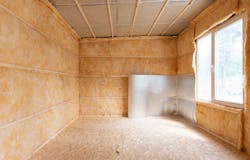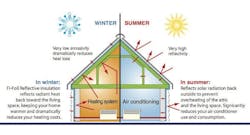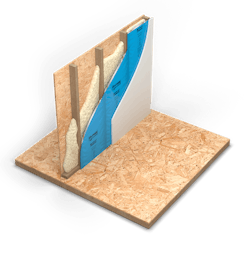Reflective Insulation: Performance, Installation, and Benefits
A home’s insulative barrier works to slow the transfer of heat, which can move either through conduction, convection, or radiation. Common insulation materials like fiberglass, wool, and foam provide a thick layer that slows heat transfer through conduction and convection, but radiant cooling works a little differently.
When the sun’s radiant energy hits the surface of a roof, it sends heat by conduction through the roofing materials and into a home’s attic. The hot roof material then radiates that gained heat energy into cooler parts of the attic. Reflective insulation is designed to reduce heat gain by redirecting radiant energy back to its source.
Radiant heating process
Image: Fi-Foil Company
Performance
Reflective insulation relies on layers of aluminum, paper, and/or plastic to not only trap air and thus reduce convective heat transfer, but to also reduce radiant heat transfer. “Roof applications are attractive for reflective insulations, especially in cooling-dominated climates, because RSI values are greatest for heat flow down,” says David Yarbrough, Founder and Vice President of insulation testing lab R&D Services.
While traditional insulation materials like fiberglass or foam board absorb heat, reflective insulation products like Fi Foil’s HY-Fi Hybrid Insulation System installed on frame walls and in ceilings (particularly in attic spaces) block heat by reflecting it back to the source while sandwiching fiberglass and polyethylene paper to minimize convection as well.
“A reflective insulation is an effective barrier against radiant heat transfer because it reflects almost all of the infrared radiation striking its surface and emits very little of the heat conducted through it,” says the Reflective Insulation Manufacturers Association (RIMA) International in its reflective insulation handbook. “By virtue of its impermeable surface, reflective insulation also reduces convective heat transfer.”
In addition, non-perforated radiant barriers can double as vapor barriers, but only when installed to create a tight seal. “Generally, these products have a very low water vapor and air permeance,” RIMA adds. “When installed properly, with joints taped securely, reflective insulation materials are efficient vapor retarders and an effective barrier to air and radon gas.”
Fi-Foil Company's HY-Fi reflective insulation system
Image: Fi-Foil Company
Installation
The efficiency of radiant barriers or reflective insulation systems depends largely on their installation, and while they’re easier to incorporate into new homes, they can be installed in existing buildings as well.
It’s important to note that reflective insulation can conduct electricity, so installers should avoid making contact with bare electrical wiring. To prevent conduction, an air gap of at least 1 inch (2.5 cm) must be made between the foil barrier and the bottom of the roof. Without an air pocket, the reflective insulation will not be effective, reports the US Department of Energy.
Once those preliminary steps are completed, the material can simply be stapled to the bottom of the roof rafters foil-face down to minimize dust accumulation on the reflective faces.
Reflective insulation systems like the HY-Fi Hybrid barrier can have R-values sometimes surpassing 20, and they can also be installed in addition to other insulation products like fiberglass for an even stronger thermal barrier.
Because an R-value measures a material’s ability to slow conductive heat, radiant barriers have no R-value on their own, but the aluminum and foil materials commonly used in reflective insulation reduce radiant heat transfer by as much as 97%, according to the RIMA.
READ MORE: How To
Efficiency
Not only is reflective insulation effective at blocking radiant heat, but because it’s made with no chemicals and uses a natural heat source, it’s also a “non-toxic, user- and building owner-safe, and environmentally-safe building material,” according to RIMA. In addition, reflective insulation products are typically recyclable and thus can be termed a Green Building Material.
Reflective insulation systems can provide as much as 10% in savings compared to fiberglass, according to the DOE. By reducing heat gain in residential structures, they may also allow for a smaller air conditioning system, meaning less energy consumption and lower utility costs for homeowners, the DOE adds.
When paired with other insulative layers, reflective insulation yields a higher R-value and can be potentially more efficient long term.


